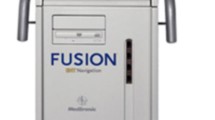Summary
Minimal invasive endoscopic operations in the paranasal sinuses rely on the detailed knowledge of the individual anatomy, in particular the relationship of the sinus system to neigh-bouring delicate and vulnerable anatomical structures. Digital CT and MR images are used for 3D reconstruction of the operating field, providing the basis for most 3D navigation systems, guiding the surgeon in close vicinity to delicate structures and so minimising the risk of iatrogenic trauma. We report the application of the ISG Viewing Wand, a computer-assisted navigation system, in endoscopic endonasal surgery related to the anatomy of the paranasal sinuses.
Résumé
Les interventions menées sous endoscopie sur les sinus paranasaux nécessitent une connaissance détaillée de l'anatomie individuelle, en particulier celle des rapports de ces sinus avec les structures anatomiques environnantes, fragiles et vulnérables. Les images digitalisées issues de tomographies computérisées (TDM) et d'imagerie par résonance magnétique (IRM) sont utilisées pour la reconstruction en trois dimensions (3D) du champ opératoire, fournissant la base de la plupart des systèmes de navigation 3D, pour guider le chirurgien au voisinage immédiate de structures fragiles et minimiser ainsi le risque de lésions iatrogèniques. Nous rapportons l'application du système de navigation assisté par ordinateur ISG Viewing Wand dans la chirurgie endoscopique endonasale, en rapport avec l'anatomie des sinus paranasaux.
Similar content being viewed by others
References
Anon JB, Lipman SP, Oppenheim D, Halt RA (1994) Computer-assisted endoscopic sinus surgery. Laryngoscope 104:901–905
Carrau RL, Snyderman CH, Curtin HB, Weissman JL (1994) Computer assisted frontal sinusotomy. Otolaryngol Head Neck Surg 111: 727–732
Drake JM, Rutka JT, Hofmann HJ (1994) ISG Viewing Wand System. Neurosurgery 34: 1094–1097
Hajek M (1904) Zur Diagnose und intranasalen chirurgischen Behandlung der Eiterungen der Keilbeinhöhle. Arch Laryngol 16: 105–108
Halle M (1906) Externe oder interne Operation der Nebenhöhleneiterungen. Berl Klin Wochenschr 43: 1369–1372, 1404–1407
Kinsella JB, Calhoun KH, Bradfield JJ, Hokanson JA, Bailey BJ (1995) Complications of endoscopic sinus surgery in a residency training program. Laryngoscope 105: 1029–1032
Korves B, Klimek L, Mösges R (1996) Surgical decompression in endocrine orbitopathy — a three dimensional localizing device ensures greater safety. Oto Rhino Laryngol 58: 46–50
Messerklinger W (1987) Die Rolle der lateralen Nasenwand in der Pathogenese. Diagnose und Therapie der rezidivierenden und chronischen Rhinosinusitis. Larngol Rhinol Otol 66: 293–299
Mosher P (1912) The applied anatomy and the intranasal surgery of the ethmoid labyrinth. Trans Am Laryngeal Assoc 34: 25–45
Olivier A, Germano IM, Cukiert A, Peters T (1994) Frameless stereotaxy for surgery of the epilepsies: preliminary experience. J Neurosurg 81: 629–633
Ossoff RH, Reinisch L (1994) Computer assisted surgical techniques: a vision for the future of Otolaryngology — Head and Neck Surgery. J Otolaryngol 23: 354–359
Roth M, Lanza DC, Zinreich SJ, Yaisem D, Sanclan KA, Kennedy DW (1995) Advantages and disadvantages of three-dimensional computed tomography intraoperative localization for functional endoscopic sinus surgery. Laryngoscope 105: 1279–1286
Sandeman DR, Patel N, Chandler C, Nelson RJ, Coakham HB, Griffith HB (1994) Advances in image-directed neurosurgery: preliminary experience with the ISG Viewing Wand compared with the Leksell G frame. Br J Neurosurg 8: 529–644
Stammberger H (1986) Endoscopic endonasal surgery. Concepts in treatment of recurring rhinosinusitis. Part I: Anatomic and pathophysiologic consideration. Part II: Technique. Otolaryngol Head Neck Surg 94: 143–156
Wigand ME (1981) Transnasal ethmoidectomy under endoscopical control. Rhinology 19: 7–15
Wigand ME (1990) Endoscopic surgery of the paranasal sinuses and anterior skull base. Thieme, Stuttgart New York
Zinreich SJ, Tebo S, Long DL, Brem H, Mattox DE, Loury ME, van der Kolk CA, Koch WM, Kennedy DW, Bryan RN (1993) Frameless stereotaxic integration of CT imaging data: accuracy and initial applications. Radiology 188: 735–742
Author information
Authors and Affiliations
Rights and permissions
About this article
Cite this article
Gunkel, A., Freysinger, W. & Thumfart, W. 3D anatomo-radiological basis of endoscopic surgery of the paranasal sinuses. Surg Radiol Anat 19, 7–10 (1997). https://doi.org/10.1007/BF01627727
Received:
Accepted:
Issue Date:
DOI: https://doi.org/10.1007/BF01627727




